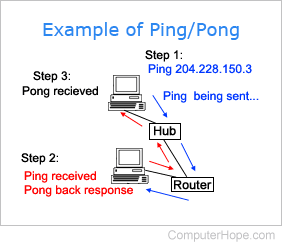Ping
Ping may refer to any of the following:

1. Ping is a utility created by Michael Muss in 1983 that's used to verify whether or not a network data packet can reach an address without errors. The ping utility is commonly used to check for network errors.
The image is an example of what happens when a ping is sent. The user would start using the ping command to ping the IP address 204.228.150.3. Next, the request is sent over the network hub and router, in this example, to the other computer with this IP (Internet Protocol) address. Once successfully received, the computer replies to the ping with a pong response. The time between these two transmissions is calculated to generate an average response or latency time.

In the example above, we open the Windows command line to use the ping command. Then we ping "computerhope.com" and get four responses from the server. In each above reply it contains the packet size (bytes), the time it took in ms, and the TTL (time to live).
If the ping does not reach its destination because of an error or being blocked, the sending computer encounters a request timed out error or shows no received packets.
The ping command output can also be directed to a file instead of the command prompt window. Working with the example ping command above, we could use the following command.
ping computerhope.com > ping.txt
The command above outputs the results of pinging computerhope.com to a file named ping.txt. The file is created in the directory where the ping command was executed. In the first example above, the directory is c:\cgi-bin\update and this is where the ping.txt file is created. To change the directory where the output file is created, we can enter a different directory in the ping command itself, as in the example below.
ping computerhope.com > c:\output\ping.txt
The example command above creates the ping.txt file in the c:\output directory, instead of in the c:\cgi-bin\update directory.
How does ping work?
When you ping another computer or device, the ping command sends an ICMP (Internet Control Message Protocol) echo request to test it and then waits for a reply. If a reply is received, it was successful. If not, an error is shown.
What is ping short for?
Ping is not an acronym or short for anything. It is sometimes thought of as the backronym packet Internet groper. The word "ping" comes from the sound sonar generates when it detects objects under water.
2. In networked computer gaming, ping is a measurement of the latency of the game's network connection to the server, measured in ms (milliseconds). Low ping, indicating low latency, indicates a good connection, resulting in more responsive gameplay. High ping indicates network congestion or problems with the server, and may result in poor responsiveness, or "lag." For example, a player with a low 50 ms ping is going to have a better gaming experience than a player with a 250 ms ping.
To help with server response times, some game servers may only accept users who have a low ping.
3. On Discord, ping is when you send a notification to another user by typing the @ (at symbol) followed by their name. For example, while in Discord if you typed "@ComputerHope are you there?" that would ping the user ComputerHope and likely get a response faster.
Most people do not like to be pinged, unless it's important. If you ping someone every time you want to talk, you likely get blocked.
What is a ghost ping?
A ghost ping is when someone pings another user or role on Discord and then deletes the message with the ping. When the user who received the ping notification comes to see who pinged them, they'll have no idea who pinged them.
Echo, Game terms, HELO, ICMP, Latency, LPB, Network terms, Ping of death, Ping pong
